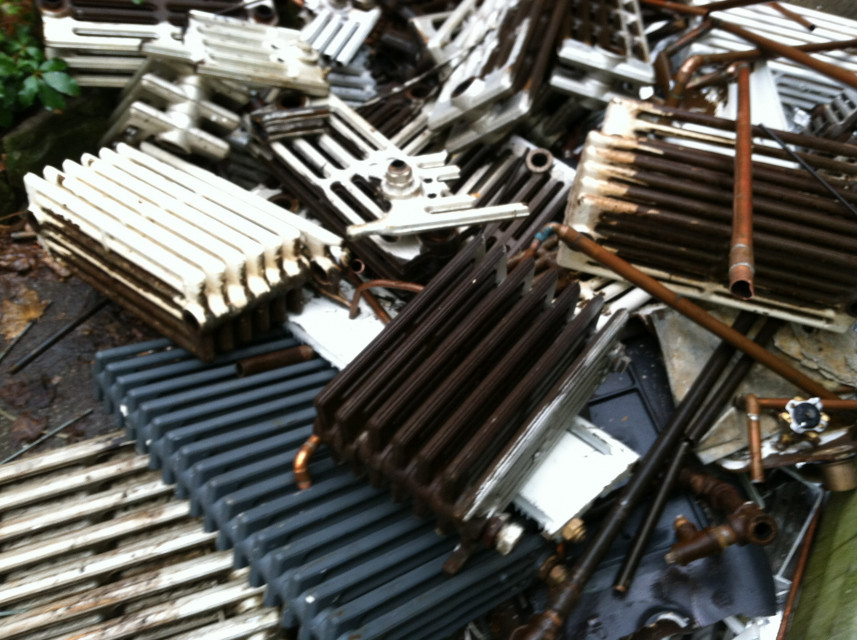In this presentation, Gary Klein shares important information about air source heat pump water heaters (HPWH), with particular attention paid to where the warm air comes ...
How Not To Size Radiators

The guy was wearing clean Docker slacks, a wrinkle-free, red golf shirt and boat shoes. He didn’t fit in with the plumbers and heating contractors who were waiting their turn to be helped. The two countermen worked as quickly as they could. Each leaned over a metal order box and wrote down what the contractors needed that day. This wholesaler hadn’t gone for computers yet. These guys liked to do things the old-fashioned way.
Another contractor walked in. The countermen looked up and shouted, "Jeez, look who’s here! Hey, make sure the cash drawer is locked." The contractor answered with a disparaging remark about the counterman’s heritage, and everyone laughed. Even the homeowner in the clean Dockers smiled.
The new contractor cut ahead of the homeowner, by saying, "Excuse me," and pointing to the sign over the counter that read, WE SERVE THE TRADE FIRST. The homeowner didn’t seem to mind. He patiently waited his turn.
Finally, one of the countermen asked the guy what he wanted.
"I need a new radiator," the homeowner explained, producing a Polaroid photo from his shirt pocket. "Here’s a picture of what the old one looked like."
"You still got this one?" the counterman asked, staring at the photo, which showed a freestanding, cast-iron radiator from the Thirties.
"No, we threw that one away," the homeowner explained.
"Oh," the counterman said as he counted the sections on the old radiator with the tip of his pen. "You have a one-pipe steam system, right?"
"Yeah, I think so."
"Do you remember how high this radiator was?"
"Thirty-two inches from the floor to the top," the homeowner said, proud of himself for being smart enough to have taken that measurement. "I also have all the other dimensions," he said.
"Hang onto them," the counterman answered as he flipped through a four-foot-thick catalog on a metal stand. "I don’t think I’ll need them." The counterman tapped some numbers into a calculator, and then gave the homeowner the current price for a replacement cast-iron radiator.
The homeowner stared to gag. "Are you nuts?" he shouted.
"That’s what they cost," the counterman said with a shrug.
"But that’s a lot!" the homeowner sputtered.
"You think so?" The counterman shrugged again. "Maybe you can fix the old one?"
"No. I told you we threw that one away."
"How come?" the counterman asked. "Was it leaking?"
"No, it wasn’t leaking," the home owner said with annoyance. "It just wouldn’t get hot all the way across. I told you that!"
"Maybe you should have changed the air vent instead of the whole radiator?" the counterman suggested.
Good one, eh? And the best part is, it's a true story!
Here's another one. A contractor called to ask me about another cast-iron radiator. "I'm looking at the charts in your Golden Rules of Hydronic Heating book," he said, "and I think this radiator is much too small for the room that it’s in."
"How big is the radiator?" I asked.
"According to the book, the radiator is good for 35 square feet."
"Well, let’s see," I said. "Thirty-five square feet EDR is equal to 8,400 BTUH when you’re using low-pressure steam. What’s the heat loss of the room that it’s in?"
"I don’t know."
"Well, how big is the room?"
"It’s ten-by-ten," he said.
"How much heat loss can you have in a ten-by-ten-foot room?" I asked. "Are there a lot of windows?"
"No," he said. "It’s just a bedroom. It’s got one window. Regular size."
"Are there rooms next to this bedroom?"
"Yeah."
"Are they heated?"
"Yeah, they are."
"Is there a heated space above and below this room?
"Above there is. Below is just the basement, and that’s not heated all the time.
"Is this bedroom we’re talking about cold?" I asked.
"No, it heats okay."
"Then what makes you think the radiator in the room is too small?"
"Well, according to the charts, it’s only good for 35 square feet, but the room that it’s in is ten-by-ten."
"So?"
"So the room is a hundred square feet! Ten by ten right? This radiator’s only good for 35 square feet. It should be at least three times bigger than it is to heat this room, right?"
"Wait a minute," I said. "You think the square foot EDR rating of the radiator has something to do with the square foot area of the floor?"
"Yeah. I mean. . . doesn’t it?"
"No."
He started to laugh. "Do you know how many years I’ve been sizing radiators that way?"
"Too many?"
"I guess so," he admitted, and laughed again.
There is a power in the way we are taught to do things when we are young that is unbelievably strong. That power can reach across the generations, and scramble our brains.
An engineer called yesterday to say his client needed more heat in a certain space that was currently being heated with copper-fin-tube baseboard convectors. He was going to specify cast-iron baseboard to replace the copper. I asked why and he said, "So the client can have more heat, of course! But I can’t lay my hands on the right catalogs. Maybe you can. Do you know how much more heat cast-iron baseboard puts out?"
"Compared to copper-fin-tube?" I asked.
"Yes," he said.
"What temperature water are you going to use?" I asked.
"The average water temperature will be 170 degrees," he said.
I looked it up and told him that he could expect to get about 540 BTUH per linear foot from the copper fin-tube convectors. The cast-iron baseboard would provide him with 550 BTUH per linear foot.
"But that’s only 10 more BTUH per foot!" he shouted in astonishment. "You must be making a mistake."
"Nope," I said. "You can check it out for yourself. Here are the names of the catalogs I’m looking at. Call the manufacturers and ask them to send them to you."
"But I should get more output from cast-iron!" he insisted. "That’s ridiculous!"
"You will get more," I said. "Ten BTUH per linear foot more."
"But that’s not nearly enough! I wanted more. And I already sold the client on this! Do you know how much cast-iron baseboard costs? Oh, what am I going to do now?"
"You could admit you made a mistake; say you’re sorry, and start over."
"No, I can’t do that," he said.
"Well, what made you suggest this option without checking?" I asked.
"I just figured cast-iron would put out more heat than copper," he said.
"Why?"
"Because it’s heavier?" he said.
"Oh."
There was once a time when a square foot of radiation meant, literally, one square foot of surface area on the radiator. When they filled the radiator with 1-psi steam, each square foot of surface would pump out 240 BTUH - as long as the air surrounding the radiator was 70 degrees. Make the air cooler, and the radiator would put out more heat. The opposite also was true. Still is.
Toward the end of the 19th Century, foundries began to elevate radiator-making to an art form. To increase the surface area, while decreasing the overall size of the radiators, manufacturers began to give their units more nooks and crannies than a beehive. The challenge was how to measure the surface area of these old beauties.
The Dead Men solved the problem in a most ingenious way (and ask yourself if you would have been able to figure this one out).
Now, remember what they were trying to do was just measure the outside surface area of the radiator. Not the inside, not how much space it took up - just the outside.
So here’s how they did it: They got themselves a big vat filled with paint, which they put on a scale. Next, they plugged all the holes in the radiator, hung it from a thick chain, and then slowly lowered it into the paint.
They let the radiator sit in the vat for a while - long enough for the paint to find its way into every cast-iron angle, twist and turn. Then they raised the radiator from the vat, letting the excess paint drip off. They weighed the vat again, knowing that the paint that was no longer inside the vat would now be clinging to the outside surface of the radiator! Finally, they’d put that much paint in a can . . . and then they painted the floor with it. The amount of floor surface they could cover with the paint became the square foot EDR rating of the radiator. Pretty cool, eh?
As time went by, they figured out how to measure a radiator’s output by weighing the condensate that came out of it. After they had this more-modern method worked out, one nostalgic engineer went back and checked it out against the Paint Method. To his delight, the measurements were remarkable similar!
It’s just that with the Paint Method, they needed really big testing laboratories.
Leave a comment
Related Posts
This all-technical, three-hour seminar will make you familiar with the many types of old steam heating systems and what goes wrong with them. Dan Holohan’s easy-to-follow...

In this all-technical three-hour seminar, Dan Holohan will give you a Liberal Arts education in those Classic Hydronics systems. He’ll have you seeing inside the pipes as...